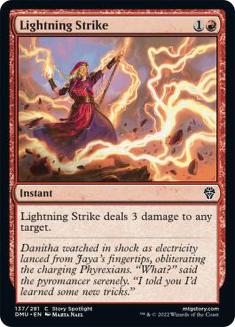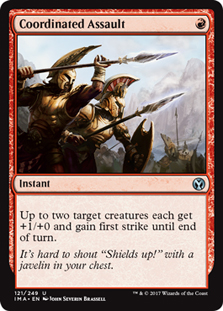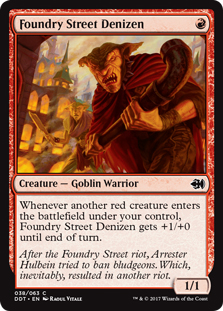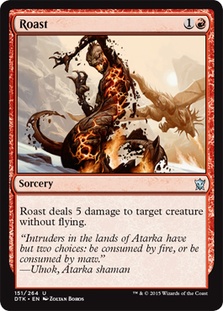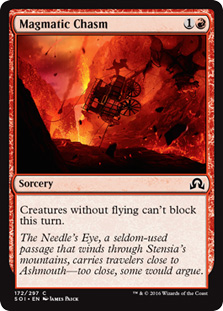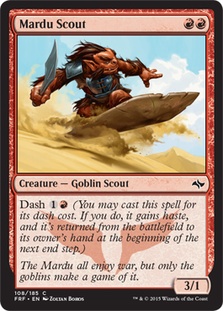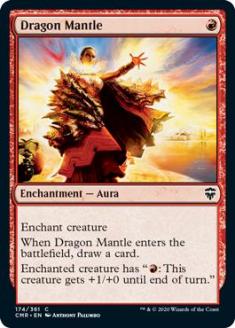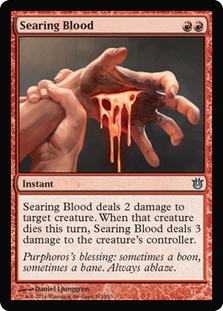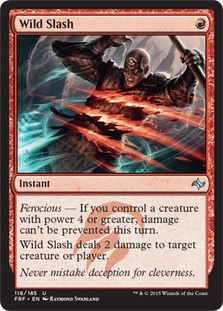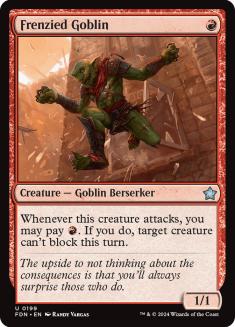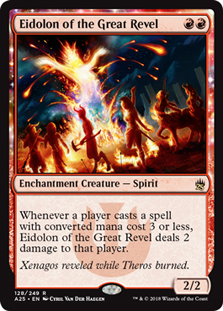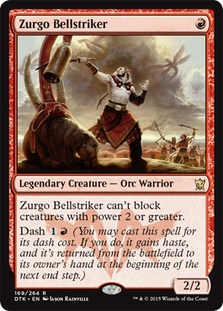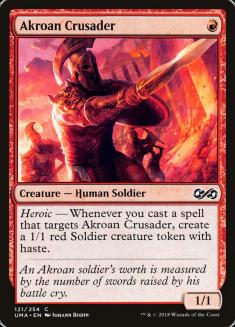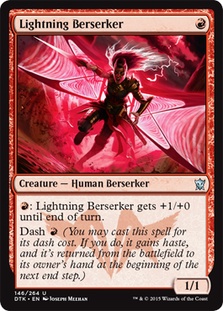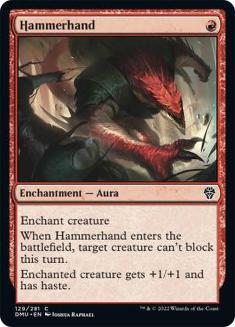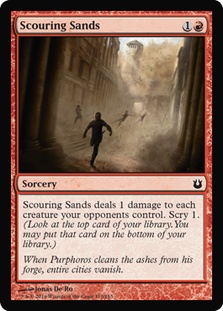As you may know, I played Mono-Red Aggro (or Boss Sligh as many have called it) at the two Invitationals that I won last year. In my last two Constructed
Grand Prix, I didn’t play Mono-Red Aggro and regretted not doing so. The Season One Invitational in Richmond this weekend will break in a fresh new format
where we’ll see the impact of Dragons of Tarkir immediately and, depending on how that tournament shapes out, will likely set the framework for the
upcoming Pro Tour in Brussels.
New formats are always a wild west of new brews battling against each other. Lists are untuned and people generally play the more expensive and powerful
cards from the newest set before it becomes common knowledge which are efficient enough to truly be Standard playable and which aren’t. The first glimpse
into a new format is the perfect opportunity for hyper-aggression to blindside everybody. Additionally, when the cardpool is so large like it is right now,
there tends to be enough cards for powerful mono-colored strategies to exist.
Mono-Red Aggro is cheap and blunt. Akroan Crusader style red decks are called anything from Boss Sligh to Blitz to Heroic Red, but regardless of the name,
one truth remains: The deck is inexpensive and delivers an unforgiving beatdown with a mix of disregarded red commons. The weapon of choice today is
affectionately nicknamed “A Sock Full of Pennies” as per the outbursts of Patrick Sullivan and Cedric Phillips following the conclusion of the Season Two
Invitational last year in Columbus.
Creatures (21)
- 2 Frenzied Goblin
- 4 Foundry Street Denizen
- 4 Akroan Crusader
- 4 Monastery Swiftspear
- 1 Mardu Scout
- 3 Lightning Berserker
- 3 Zurgo Bellstriker
Lands (17)
- 17 Mountain
Spells (22)
- 4 Dragon Fodder
- 2 Lightning Strike
- 3 Dragon Mantle
- 4 Titan's Strength
- 1 Coordinated Assault
- 4 Stoke the Flames
- 4 Hammerhand
Sideboard

This version eschews three-drops like Hordeling Outburst and Goblin Rabblemaster in favor of a gameplan that operates with only two Mountains. The main way
this deck loses is to drawing too many lands. The deck is functional for a while on only one Mountain, and nearly all one-land opening hands are keepable.
What the deck lacks in objective card power, it makes up in both synergy and card density. You’ll cast more spells on average than your Standard opponents,
which gives you some breathing room for when they get a two-for-one against you. Additionally, with more spells gives more lines of play, so the optimal
one may be harder to find, but more choices is always a good thing.
Akroan Crusader is back with the targeting package to go along with it. Hammerhand, Dragon Mantle, Titan’s Strength, and a lone Coordinated Assault are all
present in order to enable hasty Soldier tokens. The great thing is that all of those cards are completely fine on their own when targeting a different
creature. The real payoff is the burst damage alongside Foundry Street Denizen that often leads to the opponent taking near-lethal damage as early as turn
3.
Imagine this sequence:
Turn 1: Mountain. Foundry Street Denizen.
Turn 2: Mountain. Akroan Crusader. Hammerhand it. Attack for six.
Turn 3: Double Titan’s Strength the Akroan Crusader. Attack for fourteen.
Dragon Fodder is a new addition from Dragons of Tarkir that does most of what you want from Hordeling Outburst, which is to go wide enough to get damage
past blockers while being explosive with Foundry Street Denizen. It’s even a spell for Monastery Swiftspear triggers. With a lower land count, this switch
is exactly what the deck needed.
While the deck doesn’t want to draw too many lands, we now have more uses for excess Mountains. Dragon Mantle and Lightning Berserker ensure that you will
rarely finish a turn with unused mana. However, having multiple copies can turn into inefficiency so we have only three of each.
Lightning Berserker is now the upgraded choice over Firedrinker Satyr. The Berserker doesn’t attack as efficiently when you’re curving from a one-drop into
two more on turn 2, but the upsides (and lack of downside) of pumping for only one red mana and the dash ability more than make up for it. Zurgo
Bellstriker fills the gap that was left when Rakdos Cackler rotated out of Standard. Given his legendary status, drawing him in multiples gets awkward
sometimes, so three feels like the right number. For the first time in a long time, Mono-Red Aggro has a wealth of one-drop creatures available – more than
enough to play a little of whichever you like. Diversification in that aspect has the added advantage of playing well against Bile Blight.
Without Legion Loyalist, Madcap Skills, and Rubblebelt Maaka from previous Boss Sligh builds, the deck needs a way to get around blockers.
Creatures like Siege Rhino and Courser of Kruphix have so much toughness that it’s tough to burn them without either costing yourself two cards or slowing
down your attack with Stoke the Flames. Roast out of the sideboard will help in these situations, but that’s not a card I want in my maindeck. Hammerhand
and Frenzied Goblin are here to punch through blockers on critical turns. There aren’t a ton of copies of that effect, so the intent is to crash for a
large amount in a single turn, then simply alpha strike with whatever random creatures you have until enough of them get through for lethal.
Dragons of Tarkir gave Mono-Red Aggro tons of new cards, and the sideboard isn’t missing out one bit. Magmatic Chasm is a blessing against decks that
intend on beating your swarm of creatures with their own swarm of blockers. Courser of Kruphix and other larger toughness creatures were such a problem
that I was running Bathe in Dragonfire before to deal with them. Now that we have access to Roast, some of the more difficult matchups have become easier
to manage. Any double Siege Rhino draw was nigh unbeatable, but now Mono-Red Aggro has a glimmer of a chance of going toe-to-toe against the herd.
VS Abzan Midrange
Out:
In:
This matchup is fairly tough if they don’t stumble and curve into Courser of Kruphix and Siege Rhino. They have Drown in Sorrow and Bile Blight after
sideboard, so be wary of those before overcommitting to the board. If they have Fleecemane Lion, consider keeping in Lightning Strike and taking out a
Zurgo Bellstriker and a Dragon Fodder instead.
VS R/W Aggro
Out:
In:
Hordeling Outburst is tough to push through, so some one-toughness creatures get sideboarded out. Wild Slash and Searing Blood are great since all of their
creatures are 2/2s. Chained to the Rocks is normally a good removal spell against creature decks, but they will only trade for another another one-mana
spell against you. Dragon Mantle has a lower than usual chance of resolving against them so a few of those get shaved.
VS U/B Control
Out:
In:
This is a matchup that Mono-Red Aggro preys on. Their spells like Dig Through Time, Jace’s Ingenuity, and Ugin, the Spirit Dragon are too slow to make an
impact, and their Hero’s Downfalls and Cruxes of Fate are too inefficient against your creatures. In sideboarded games, they catch up a bit when they lower
their curve and fill up on Bile Blight and Drown in Sorrow, but this is when your dash creatures are at their best.
VS Sultai Control
Out:
In:
The winner of the last Open Series event in Dallas, Sultai Control has proven to be a great deck in the hands of great pilots, not just Gerard Fabiano
himself. The matchup is fairly similar to U/B Control expect that they have Satyr Wayfinder and a clunkier manabase. It’s temping to bring in Searing Blood
to remove them, but you’re better off having cards that are always castable. Again, Drown in Sorrow will be their main tool to fight your swarms, so
dashing in creatures becomes your plan for the most part from turn 3 onward.
VS G/W Devotion
Out:
In:
The breakout deck from Grand Prix Miami has receded a bit in numbers, but I still see it as a strong contender moving forward into the new format. Seismic
Stomp has been key in beating the green-based devotion decks of last season, and I’m very happy to get a functional reprint in Magmatic Chasm. This is also
the strongest matchup for Roast, as a turn 3 Polukranos, the World Eater is hard to fight through no matter how fast your draw is.
VS W/U Heroic
Out:
In:
You want to have a healthy amount of removal against their early creatures but not so much as to draw too many once their Heroic creature becomes too big.
Every now and then you can get ferocious, which gives extra value to your Wild Slash in instances where it can turn off the protection from Favored
Hoplite, Gods Willing, or Feat of Resistance. Ordeal of Heliod sure is a headache, and you just hope that they either not draw it or that you put them out
of position to trigger it before you kill their hero.
VS Mono-Red Aggro
Out:
In:
You’re sideboarding to win in a world of 1/1 creatures. They may have Arc Lightning or their own Scouring Sands, so you cut down on as many one-toughness
creatures as you reasonably can. Eidolon of the Great Revel is a double-edged sword here, but a 2/2 is a 2/2, and drawing one is fine even if you’re
slightly behind as well as being great when you’re ahead.
I’ve made a habit of writing about the Mono-Red Aggro list I end up playing right before the SCG Invitationals. For some reason people don’t respect it in
those tournaments and instead expect other people to weed out the hyper-aggression instead of dedicating sideboard slots to it themselves. With the Season
One Invitational beginning tomorrow, Mono-Red Aggro is currently on my short list of decks to play. If I don’t, I’ll be sure to pack a deck that’s capable
of beating it.


